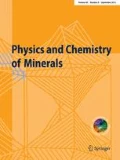Abstract
In order to gain insight into the correlations between 29Si, 17O and 1H NMR properties (chemical shift and quadrupolar coupling parameters) and local structures in silicates, ab initio self-consistent field Hartree-Fock molecular orbital calculations have been carried out on silicate clusters of various polymerizations and intertetrahedral (Si-O-Si) angles. These include Si(OH)4 monomers (isolated as well as interacting), Si2O(OH)6 dimers (C2 symmetry) with the Si-O-Si angle fixed at 5° intervals from 120° to 180°, Si3O2(OH)8 linear trimers (C2 symmetry) with varying Si-O-Si angles, Si3O3(OH)6 three-membered rings (D3 and C1 symmetries), Si4O4(OH)8 four-membered ring (C4 symmetry) and Si8O12(OH)8 octamer (D4 symmetry). The calculated 29Si, 17O and 1H isotropic chemical shifts (δi Si, δi O and δi H) for these clusters are all close to experimental NMR data for similar local structures in crystalline silicates. The calculated 17O quadrupolar coupling constants (QCC) of the bridging oxygens (Si-O-Si) are also in good agreement with experimental data. The calculated 17O QCC of silanols (Si-O-H) are much larger than those of the bridging oxygens, but unfortunately there are no experimental data for similar groups in well-characterized crystalline phases for comparison. There is a good correlation between δi Si and the mean Si-O-Si angle for both Q 1 and Q 2, where Q n denotes Si with n other tetrahedral Si next-nearest neighbors. Both the δ i O and the 17O electric field gradient asymmetry parameter, η of the bridging oxygens have been found to depend strongly on the O site symmetry, in addition to the Si-O-Si angle. On the other hand, the 17O QCC seems to be influenced little by structural parameters other than the Si-O-Si angle, and is thus expected to be the most reliable 17O NMR parameter that can be used to decipher Si-O-Si angle distribution information. Both the 17O QCC and the 2H QCC of silanols decrease with decreasing length of hydrogen bond to a second O atom (Si-O-H···O), and the δ i H increase with the same parameter.
Similar content being viewed by others
Author information
Authors and Affiliations
Additional information
Received: 18 July 1997 / Revised, accepted: 23 February 1998
Rights and permissions
About this article
Cite this article
Xue, X., Kanzaki, M. Correlations between 29Si, 17O and 1H NMR properties and local structures in silicates: an ab initio calculation. Phys Chem Min 26, 14–30 (1998). https://doi.org/10.1007/s002690050157
Issue Date:
DOI: https://doi.org/10.1007/s002690050157




